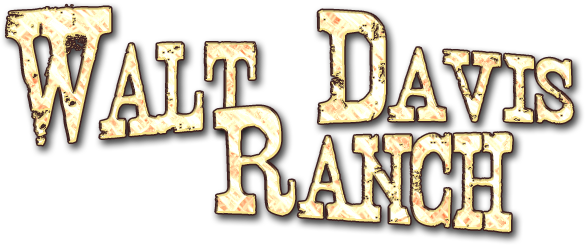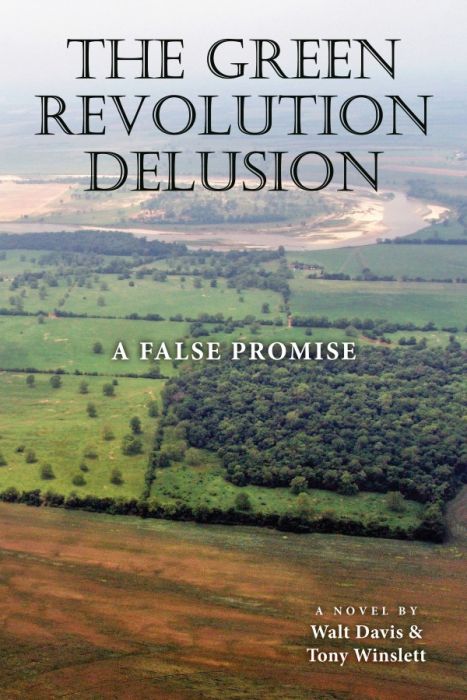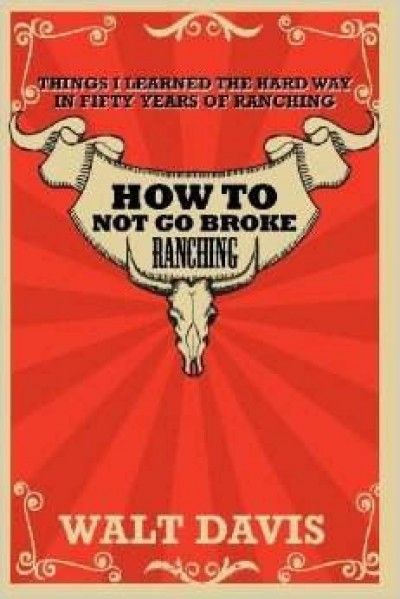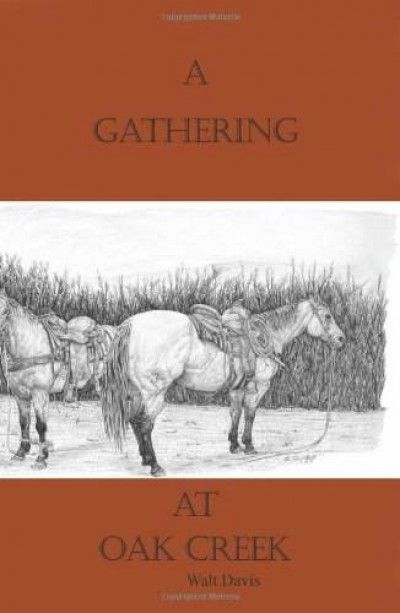
Walt Davis - Author, Agricultural Consultant, and Rancher

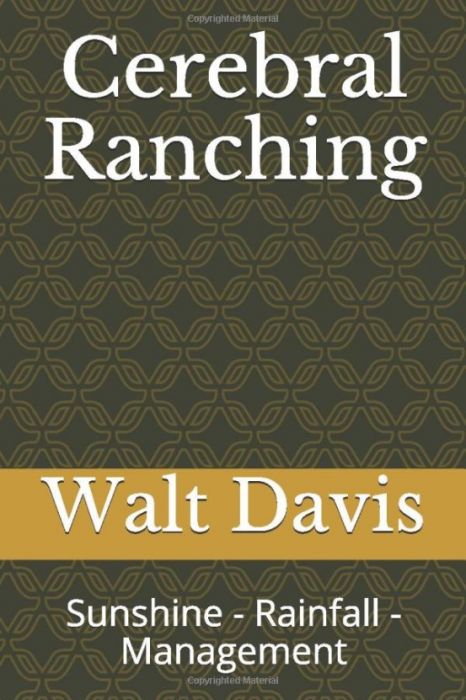
$29.95
Cerebral Ranching
Sunshine - Rainfall - Management
By Walt Davis
Cerebral Ranching is a collection of bite
sized bits of management philosophy – along
with corresponding practices – that work
together to improve the ecological, the financial, and the human aspects of
ranching. It is not a “how to” book but rather an attempt to help managers use
logic to replace the multitude of inputs – all expensive, most toxic – deemed
necessary by the proponents of modern
agricultural technology. It recommends a holistic (all inclusive) type of
management, with examples of individual practices that support holistic
management. The purpose of the book is not to advocate some utopian Polly Anna dream
world, but rather to show how ranching can be (and is in some cases) a powerful
factor for regenerating natural resources, while producing economic profit, and
being a good way to live and raise a family.
Many of the ideas put forth are in direct
conflict with the tenets of industrial agriculture, which today is widely
accepted as the modern standard. There are many differences between what is
considered conventional ranching and
what I term cerebral. Most of these arise from differences in the underlying philosophies
of the two approaches. Industrial agriculture operates on the false, and
short-sighted, belief that for humans to
succeed, nature must be dominated – kill weeds, kill insects, kill microbes, destroy
anything that interferes with the production scheme. It operates on the theory
that the natural world is controlled by competition and that human success
depends on reducing this competition by limiting the number of species present; in producing the monocultures
we call “clean crops and weed free pastures”. In truth, the natural world
operates on mutually beneficial relationships and, without human interference,
this web of relationships creates a stable and productive soil-plant-animal
complex where the needs of all organism’s present are met. Much more productive
than fighting to maintain the unstable monocultures, is increasing the
complexity of the situation by judiciously inserting two more factors into the complex –
wealth and humans. When management is designed and implemented to benefit all
parts of the soil-plant-animal-wealth-human complex, many “problems” disappear.
This is neither as difficult nor as complicated
as it sounds. It does require that managers understand that all parts of the
complex are related and anything that affects (for good or bad) one part,
affects all parts. We have gone wrong by trying to correct individual “problems”.
It is not possible to successfully treat
“fly problems, or nutrition problems, or disease problems as if they were
unrelated. So long as “problems” are addressed in isolation, they will never be
cured in a manner that brings long-term benefit to the whole complex. There are
no, “silver bullets”, chemical or mechanical, that will quickly cure individual
symptoms without creating more problems. The question as to whether to use a
practice should not be, “What will it hurt?” but “Will it help all parts of the
complex?” Many of the ills of industrial agriculture
come about from unanticipated side effects of the treatments applied to remedy “problems.”
There are many such side effects but most trace back to a loss of biodiversity –
simplification creates unstable conditions while complexity promotes stability.
As the famous philosopher, Pogo, said, “We
have met the enemy and he is us”.
Agriculture, including ranching, badly
needs to change from the current culture of “kill the pests” to one that
promotes life by strengthening all parts of the soil-plant-animal-wealth-human
complex. There are many producers all over the world striving and succeeding in
making this change. Their success – financial, ecologic, and human – is why
organic agriculture is the fastest growing type agriculture.
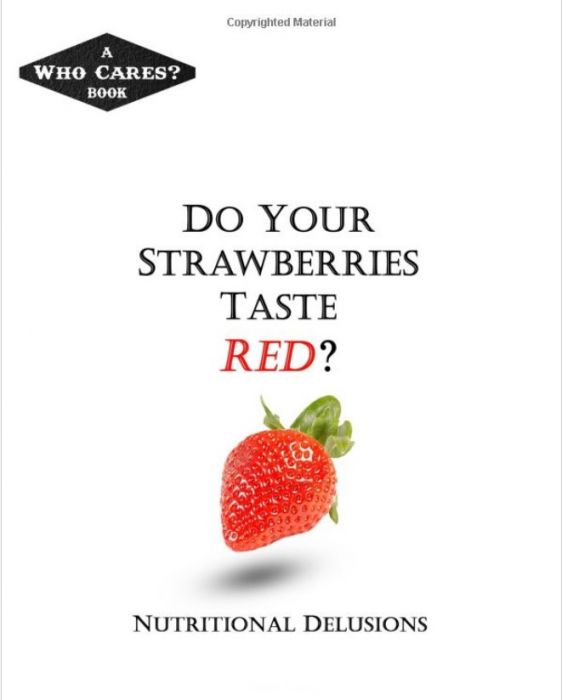
24.95
Do Your Strawberries Taste Red?
Nutritional Delusions
By Walt Davis and Tony Winslett
Why are so many people in poor health, when our world is in an unprecedented time of prosperity? Why is this happening in a society of abundance and with high availability of quality health care. Why when infectious disease killers such as small pox, cholera, typhoid, and polio have been largely conquered? It is the authors’ opinion, backed by scientific research, that most of the increase in human illness is due to poor nutrition. Not poor nutrition caused by lack of food, but rather poor nutrition caused by a lack of quality food. Quality lacking due to what should be in our food and is not, but also by what is in our food that should not be. As people become more separated from the land – the source of food – they are more at risk to the many problems of modern agriculture; some of which (along with suggested remedies) are dealt with in this book. It is sad, but in today’s world of corporate agriculture, food production is geared more to promoting profit margin, product appearance, and shelf life than to nutritional content. We have more than enough food but much of it consists of empty calories that are deficient in nutrient content. The purpose of this novel is to point out – in an easy to read form – the relationships between the nutritional quality of food and human health and to offer practical methods people can use to benefit themselves and their families. The science required to produce high quality, nutrient dense food is straight forward and well understood but it is not widely practiced by main stream food producers. There are several reasons for this but leading the parade is ignorance. Even people highly educated in the earth sciences, subscribe to the belief that to “Feed the world” we must adopt the tools and techniques of industrial agriculture. Not just the hybrid plants and enormous machines needed to till huge fields of crops grown as mono-cultures but also the full range of poisons to control pest organisms from plant diseases to internal parasites to coyotes. Poisons that can be sprayed on plants, incorporated into the soil, and even introduced genetically into plants so that insects (and people) that eat the crop, receive a dose of poison. Big Ag assures us that the dose is too small to harm large animals like us. Even more chemicals are applied as “fertilizers”. Unlike traditional fertilizers – manure, rock dusts, green manure – in concentration these acid salt chemicals kill the soil life responsible for natural soil fertility. Agriculture – the promotion of life – has become a culture of death. Mineral nutrient content of all food stuffs produced under the new regime have decreased, over the last fifty years, from thirty to seventy percent. During this period chronic diseases associated with poor nutrition have become endemic. Heart disease, diabetes, hypertension, dementia, autism, and cancer are just some of the conditions that can be helped, often cured, by the approach suggested. This does not have to require heroic efforts, it is completely feasible to gain the benefits of healthy foods without disrupting your life style. Industrial agriculture has been a disaster to the environment, to human health, and to the financial well being of agricultural producers. These problems have developed, not because people were uneducated, but because so much of what has been taught by our universities is wrong. The focus of agricultural education has become, to maximize production. Without exception, this attitude results in damage to our environment. There is a better way; a way that provides the quality food and fiber we need in a manner that is financially sound, ecologically regenerative, and human friendly.
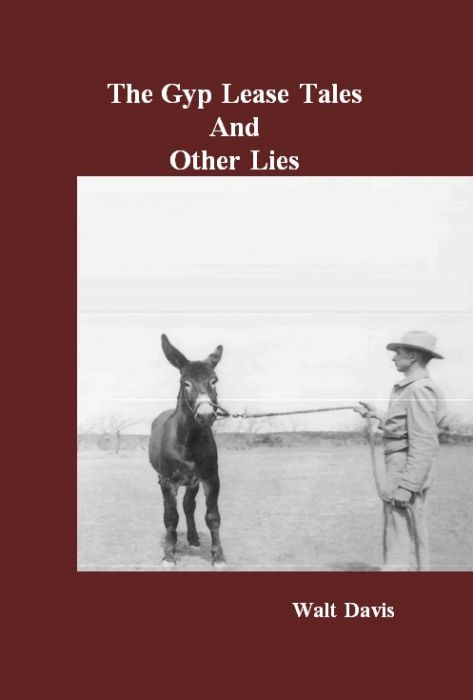
19.95
Gyp Lease Tales and Other Lies
By Walt Davis
Which Way is Up?
Between the flat ground and the thick brush, the gyp lease was an easy place to get turned around if you couldn’t see the sun. When I joined Boy Scouts, they told us if we were ever lost we could find our directions because the moss grows on the north side of trees. Problem is in west Texas moss doesn’t grow on any side of trees. Anyway, just about everybody that rode on the gyp lease, sooner or later, got lost enough that they would have to ride until they hit a fence and follow it until they could get their bearings. One smooth cloudy day Mother brought dinner out to the crew and I was along with her for the ride. Dinner for those of you not west Texans is eaten close to noon not at suppertime. Winding through the brush on the faint little dirt road, we came around a bend and nearly caused a good cowhand to die of terminal embarrassment. Walter Estes was not fifty feet off the road trying to make his horse stand still enough that he could stand up in the saddle and hope to see something he could use to figure out where in the hell he was. He had made a run through the brush and lost not only the cow but his directions as well. From the look on his face I really believe Walter would have rather have been snake bit than to have a woman and kid catch him in that predicament.
The Green Revolution Delusion
A False Promise
By Walt Davis & Tony Winslett
The Green Revolution Delusion is a portrayal of some of the real and very disturbing problems of modern agriculture. Damage is being done to farm families, to the environment and to human health.
Fiction is used as the vehicle for putting forth this information in the hope that an enjoyable reading experience will bring useful knowledge to a wider audience.
The book is not a doom and disaster tirade but rather an attempt to explain why the conventional wisdom – that we must adopt all of the current toxic technology: the confined animal feeding operations, the genetically modified organisms and the chemical fertilizers and pesticides in order for agriculture to be profitable and productive – is simply wrong.
It is not a technical dissertation but it presents, without a lot of jargon, some of the scientific and economic reasons that industrial agriculture is neither sustainable nor profitable in the long term.
The book is not a how to manual but rather it tries to at least partially explain, in a non-technical manner, the functioning of the ecological processes that control the natural world and how these processes can be used to create agriculture that is financially, ecologically and sociologically sound.
Read what land managers have to say about The Green Revolution Delusion:
Gabe Brown, Rancher, Regenertive Land Manager, Bismarck ND
I picked up the book “The Green Revolution Delusion” and did not set it down until I had read it in its entirety, it was that compelling! The story of the history of production agriculture in the USA as told by the characters in this book bring to light the fact that the industrial agriculture model being touted and used in this country is not working. It truly is a model of “False Promise”. As a producer who once believed in the industrial model and who came to realize the fallacy of it, I can tell you this book brings it all to life. It is a story that will make everyone think every time they sit down for a meal!
Robert J. Potts, President & CEO, The Dixon Water Foundation
An engaging novel exploring one of the most important issues of our time: the struggle of small family farmers against industrial agriculture.
Kathy Frisch Harris, Holistic Management/sustainable ag educator,
nutrient-dense farmer, and Weston Price Foundation activist
In this tale of triumph in the lives of multi-generational farmers, Walt and Tony pull you in with their engaging characters add a backdrop of corporate and political intrigue, and deliver vital information on health, nutrition, corporate atrocities, and effective sustainable agriculture. I've never seen such breadth and depth of knowledge presented in one compelling package! This gives me hope that more people will understand the dire situation in our food system, and be motivated to take action.
Howard Garrett - The Dirt Doctor- Author and Host of The Natural Way Radio Show
There's real life honesty and soul bearing in this book. Based on true experiences, it teaches about one of our most serious threats today and gives some strong suggestions about the solutions. The ending is a treasure - but don't skip head and cheat. Read it all.
How To Not Go Broke Ranching
Things I Learned the Hard Way in Fifty Years of Ranching
By Walt Davis
How to Not go Broke Ranching is the irreverent and sometimes humorous effort of a multi generation rancher to help people keep from making all of the mistakes that he made in fifty + years of ranching. It is drawn from real life though some names are changed or not given to protect the guilty.
The vast majority of ranches in the United States, whether commercial or life style, are neither profitable nor sustainable; the author explains why this is so and what must be done to improve the situation. The changes in philosophy and in management practices required to do this are spelled out in some detail by a man who used them to turn an almost bankrupt ranch into a consistently profitable and stable operation.
Both the new, or would be, rancher just starting out and the established rancher will find information and advice in this book that can be used to make their operation more profitable, less dependent on purchased inputs and markets and a whole lot more fun.
Read what ranchers have to say about How to Not Go Broke Ranching
Chip Hines- Rancher and Author, Colorado
Walt Davis has written a book that pokes holes in the University "Book" that has led us down the wrong trail for the last 40 years. Walt went to college and came home to the family ranch putting all he had learned to use. It was not working. The ranch was not making money.
Reality set in. It was time to use a different model. It was then that his studies of Holistic Management and practical experience alllowed him to develop a management plan for success.
This is an easy reading book full of logic which ties everything together.
Brian Russ - Rancher, Texas
Mr. Davis' book covers ranching from a new and refreshing perspective. This book is written from first-hand knowledge that ranching can be both ecologically and economically sustainable. This book details the steps needed to stop fighting nature and begin to make money and have fun while doing both.
TW Weyl, Rancher, Arkansas
Walt Davis speaks from his years of experience in livestock agriculture. He has worked with the conventional way of high input, high labor and low profit agriculture. And now works more to be in tune with nature to work with it, rather than against it.
I have incorporated many of the principles that Mr. Davis promotes several years ago into my operation. I now have dung beetles and other beneficial insects that keep internal parasites and flies is check in my cattle. I now have more grass than weeds. Even in drought conditions, I still have grass. There are always new things to see and observe each day. The real benefit from this book is that it will make you think about what you are doing and why.
It really is a old way of doing things made new. The person that can benefit the most from this book will be the one with a open mind and heart. And an willingness to take a hard look at the things that cost the most. Although this book is geared toward the livestock producer. The principles taught by Walt Davis I believe can be applied to any business.
Joe Hopping, Rancher, Oklahoma
My brother and I are in the cattle and hair sheep business and we're always looking for a better way to manage our operation. I'm an avid reader and I must say that "How to Not go Broke Ranching" is one of the VERY BEST agricultural books that I've ever read. At one time Walt managed his ranch according to how the Land Grant Universities advocated. He used nitrogen fertilizer, sprays and chemicals of all kinds, calved and kidded early, and did everything "by the book". Walt was growing lots of grass, weaning big calves, and getting lots of production but he was going broke doing it. When the cattle market went bust in the early 70's he knew he had to change things or lose his ranch and his livelihood. He started rotational grazing his pastures, quit using chemicals and sprays of any kind, changed his calving dates to be in sync with nature, added hair sheep to the livestock mix, and implemented some other practices that were unconventional at the time. By working in harmony with nature and spending as little as possible on purchased inputs Walt turned his ranch into a very profitable operation. "How to Not go Broke Ranching" is going on my desk with a few select books that I read often and time and time again. I highly recommend it to anyone in the farming and ranching business - from the beginner to someone that has spent their lifetime in the business
A Gathering At Oak Creek
By Walt Davis
A Gathering at Oak Creek, a novel, is the story of four very different people; a depiction of how they come together and how they and their ancestors are and were molded by the land and by the times in which they live. The story, which begins over one hundred and fifty years before, takes place – mainly –in the area that will become Texas. Scot-Irish, Mexican, German, Tonkawa, Irish and Comanche all have ancestral parts in the saga while the roles of African-American, Apache, English and Kiowa are essential to the story. This is an adventure tale, a seminar on ranching and ecology, a love story, and a history lesson spiced with mystery, tragedy and comedy. The story is fiction but the people and events portrayed are modeled after real life. The Scot-Irish made the journey from grinding poverty in Scotland to poverty plus religious strife in Northern Ireland to a sometimes harsh but free and independent life in America. The German settlers moved to what was at first Tejas and later Texas as family units; where the Scot-Irish and Anglo-Saxons tended to “chase the rainbow” the Germans brought civilization and stability where ever they settled. The people of northern Mexico suffered terribly for many years from the actions of predatory Comanche and Apache; it was common for Mexican and Caucasian children – especially boys – to be adopted into the tribes and live out their lives as tribesmen. The Tonkawa people were treated particularly harsh by history; at various times, they were massacred by Apache, Comanche, white settlers – with whom they had long been friends and allies – and, when they were moved to Indian Territory, by consortiums of supposedly “tame” Indians. After the War Between the States, the disarming of the people of Texas by the Reconstructionist government did happen and Texans of all kinds suffered from Indian depredation because of it. The freed slaves of the 10th United States Cavalry with their campaigns against the Comanche and later against Victorio and his renegade Apaches gave lie to the belief, common at the time that black men could not fight. The area of Texas where Oak Creek Ranch is located was some of the last land in the United States to be opened to civilization; for many years “Comancheria” – the land of the Comanche – was cut off completely from the rest of the world. No one ventured into the area without the permission of the Comanche. This continued until the buffalo herds were exterminated and the Comanche and their Kiowa allies were starved into submission. Quanah Parker brought the last of the free Comanche in to the Fort Sill Reservation in 1875 and the Comanche wars were finally over. The end of Indian hostilities ushered in a new era of settlement across the area; first by free range cattlemen pushing in from all four directions and later by farmers and small ranchers. Mac and Windy – who are featured in the story – were among the last of the free living cowboys who played such an important role in the early day ranching industry. The ranching business underwent great change from its’ early days until the 1990’s; it became much more industrialized – it moved away from its roots in the land. Today, at least some ranchers are in the process of changing once again; raiding Comanche are no longer a threat but new challenges face the ranchers attempting to take their operations back to their biological foundations. The book attempts to give some insights into ranching – past and present – in America but at the very least, it is an enjoyable read that will leave you in a good mood. The author grew up in the area where the story occurs and spent his life as a working rancher. Mike Pinson, whose original art work graces the front cover, is another fully accredited cowboy with the broken bones to prove it. Aside from his art work and cattle operation, Mike is a saddle maker and leather artist.
Read what readers say about A Gathering on Oak Creek
"West Texas is less an area then it is a state of mind."
Chip Hines Rancher on the north edge of Comancheria
Walt Davis has done something seldom done. The mix of ranching, environment, history, mystery and people is quite a handful to weave into a story built from several separate stories. Walt pulled it off with a very readable book that is plumb full of knowledge from all the different people and circumstances he has gathered into one readable volume.
The detail, whether of a conversation, situation or lay of the land puts you right there in the middle of what is going on. That is hard to pull off. Walt did it.
A very enjoyable book that also is informative.
D. H. Smith
Mr. Davis takes our minds through time from 1667 when the Indians lived in time of abundance, on through Comanche raids, German's - Scots-Irish immigration, War Between the States, Indian wars, and raising cattle in draught ridden Texas. This is a very enjoyable book to read and will enlighten you of historical facts you might not have been aware of.
Don Ivey - The Brazos Highwayman
I always approach a relatively unknown author with caution, even though in this case I have known Walt for many years. I suggest you throw caution into the nearest stock tank and enjoy a fine western tale spanning over 300 years. Davis brings a reality to this novel that is founded on a lifetime as a cowman. He started riding at age 4 on the family ranch outside Sweetwater, Texas, but didn't start riding fence till he was ten. He ran a major cattle operation on his ranch on the Red River in Oklahoma for the last 50 years and pioneered a poison free operation. Davis is a smooth fit between McMurtry, Dobie, and Michener. "The Gathering" is worth a read.
